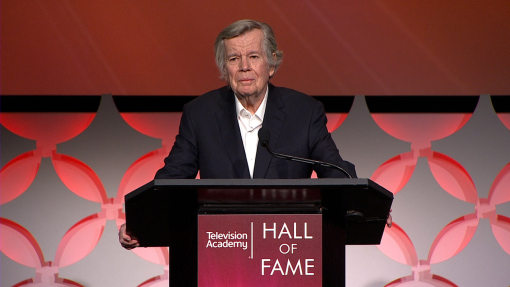"To me, it still seems miraculous that a human being could walk on the moon and even more astounding to see it happening on our television screens. The great impact of television upon our lives is that it can show and tell us events around the world as they happen, [and] it can recount and recapitulate other events soon after they occur. Broadcasting reaches into virtually every home in America. It brings into those homes not only the news of the day but the changing trends in the way we lead our lives. It binds our vast, pluralistic country together as one nation. ... " — William S. Paley
William Samuel Paley was 26 years old when he decided to sling his CBS pebble at NBC's Goliath. Taking aim with a floundering radio network of 16 affiliates, he slowly built CBS into broadcasting's greatest show. In the process, he became monarch of the airwaves — the patriarch of broadcast journalism, and the nation's leading impresario of popular entertainment.
"Quite early in the game," Paley recalled in his 1979 autobiography, As It Happened, "I evaluated the essential elements of broadcasting and came to believe that the crux of this business was programming — i.e., what went on the air. It seemed logical to me that those who put on the most appealing shows won the widest audiences, which in turn attracted the most advertisers, and that led to the greatest revenues, profits, and success."
A Chicago-born scion of a wealthy cigar manufacturer, Paley was a graduate of the Wharton School of the University of Pennsylvania. Excited by radio's possibilities after sponsoring a show through his family's business, Paley bought controlling interest in United Independent Broadcasters for $503,000 in September 1928. After he renamed the network the Columbia Broadcasting System, his first order of business was to revise the contract between the network and the 16 existing affiliates in order "not to make it less, but to make it more attractive to station affiliates," he recalled. Unlike NBC, the younger, more flexible CBS decided to give affiliates free sustaining programs, those unsponsored broadcasts used to fill gaps when neither affiliate nor network had sponsored programs. In exchange, Paley asked that the local stations allow CBS to pre-empt local time during hours when national sponsors wanted to reach the entire nation. Moreover, local stations would have to identify the network's programs with the CBS name.
After the affiliates enthusiastically accepted the new contract, Paley also succeeded in attracting a selected number of unaffiliated Southern stations to CBS under the same arrangements.
For Paley, the next order of business was to acquire a CBS-owned station from which to originate programs. He negotiated with WABC (New York) and WOR (Newark). Because it was cheaper, he bought WABC (later WCBS) in December, 1928, for $390,000. This acquisition gave CBS a transmitting station and a studio atop Steinway Hall on 57th Street.
Three and a half months after he had bought the radio network, Paley announced on the air that CBS, the new national network, had the largest chain of broadcasting stations in radio history. One newspaper headlined the news: COLUMBIA SYSTEM TO HAVE WORLD'S LARGEST NETWORK.
"It was true literally, but only literally,” Paley observed. CBS did indeed serve 49 stations in 42 cities across the nation. NBC served some 50 stations, but these were divided into two separate networks, neither of which had as many affiliates as CBS. In any case, Paley, who had succeeded in startling the broadcasting world with his announcement, was now ready to compete with the patrician NBC.
He began by developing new programs, searching for the talent to perform in them, and finding sponsors who would pay for the package. One of his first coups was to persuade Paul Whiteman, one of the country's most popular bandleaders, to perform on CBS radio on the weekly Old Gold Program, sponsored by P. Lorillard Co., makers of Old Gold cigarettes. Next, he convinced a reluctant Will Rogers to bring his brand of humor to radio. The result was CBS's Will Rogers Program, sponsored by the pharmaceutical firm of E.R. Squibb & Sons. Other talent followed, including singers Bing Crosby, Kate Smith, and the Mills Brothers, as well as the new husband-and-wife comedy team of George Burns and Gracie Allen.
Moreover, during CBS's earliest years Paley hired Edward Klauber, night city editor on the New York Times, who understood the news potential of radio and began assembling a CBS news staff who had backgrounds in journalism. Klauber developed a newspaper mentality for CBS, refusing to allow advertisers to determine how news should be covered. CBS commentators H.V. Kaltenborn and Boake Carter rose to prominence. In 1938, CBS pioneered the multiple news roundup from foreign capitals with its coverage of the German invasion of Austria. By the time World War II started, the network had established one of the most comprehensive news services in the world, featuring such stellar correspondents as Edward R. Murrow and Eric Sevareid.
After the war, Paley began turning his attention to the dawning age of television. On April 29, 1947, the first of the live drama anthologies premiered. The CBS Television Network was formed in 1948, with Philadelphia's WCAU-TV signing on as its first affiliate.
In that same year, Paley staged the coup that made him legendary. In quick succession he persuaded some of NBC's most popular blue chips to abandon that network for the welcoming arms of CBS. Jack Benny, Red Skelton, Frank Sinatra, Edgar Bergen, and Amos 'n' Andy switched to CBS, bringing their audiences with them and prompting Variety to label the raid as "Paley's Comet." With "The Great Talent Raids," as the industry called them, CBS came of age and outdistanced NBC.
That same year, Ed Sullivan and his Toast of the Town aired on the network and continued for the next 23 years, one of the longest-running programs in broadcast history. Sullivan's television debut was followed by that of the popular radio star, folksy Arthur Godfrey, who came to CBS with his Talent Scouts. Shortly afterward, Arthur Godfrey and His Friends premiered.
Paley's genius for snaring top stars continued to shine throughout the next two decades, giving CBS its position as first in the ratings for 20 consecutive years, during which period the network called itself "the largest advertising medium in the world." Some of the network's biggest hits were I Love Lucy, Playhouse 90, Twilight Zone, The Honeymooners, The Beverly Hillbillies, The Mary Tyler Moore Show, M*A*S*H, The Waltons, and All in the Family.
Under Paley, the network's news operations, duplicating its achievements in radio, eventually led the broadcasting industry to some of its finest hours: See It Now (which premiered in 1951), hosted by Edward R. Murrow; You Are There (1953), a series of dramatic reenactments of historic events, with CBS newscasters giving reports: CBS Reports (1959), with in-depth news documentaries; The CBS Evening News with Walter Cronkite (1963), expanded to a half-hour; The Twenty-First Century (1967), a series on scientific and environmental subjects; 60 Minutes (1968), the magazine-format program that has won virtually every major award in television news reporting; and CBS Morning News, which was expanded in 1969 to become network television's first one-hour news broadcast.
"Despite its critics," Paley observed of the medium he helped shape, "I believe television is better today than it has ever been before, and better than any other television system in the world. It provides programs to satisfy the tastes of a broad spectrum of Americans. I believe, too, that television will continue to improve its home entertainment, delivery of the news, and its public information service, so necessary to the people of a democratic nation, who are faced with the need to be informed on all important public issues. One needs only to stop and to consider what the United States and the world would be like today without the communications provided by the broadcasting media."
In 1966, when Paley was scheduled to retire, he waived the network's mandatory retirement rule for himself. He remained at the helm for the next 17 years, leading CBS into business acquisitions that freed the network of its dependence on earnings from broadcasting. In 1976, he established and funded the Museum of Broadcasting in New York, dedicated to preserving television history. In 1977, Paley stepped down from his post as chief executive officer and continued with CBS as chairman of the board. On April 20, 1983, at the age of 81, William Paley resigned after a broadcasting career that had spanned more than five decades.
This tribute originally appeared in the Television Academy Hall of Fame program celebrating William S. Paley's induction in 1984.











